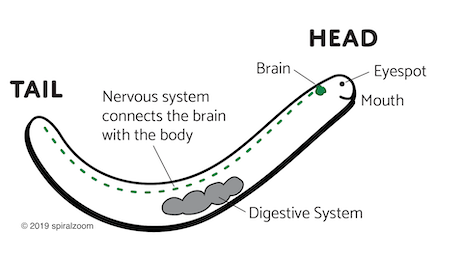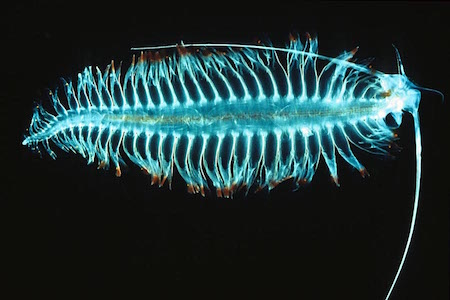 4WORMS
4WORMS
Worms appeared around 530 million years ago.
A worm is a multicellular animal that has a head at the front of its body. The first worms evolved in the ocean. Today, there are about one million different species of worms that live in a huge variety of environments. Earthworms are particularly abundant and play vital roles in keeping soil healthy.
Evolution: From Sponges to Worms
Over millions of years, some of the descendants of the sponge started to evolve a more organized body plan. At the same time, most of the other sponge species continued on as sponges successfully in their marine environments. The worm's emergence from a given species of sponge did not make the other sponges obsolete.
Our family history really starts to speed up once our ancestors began to evolve eyes and brains. Researchers have discovered that sponge larvae have very primitive visual capacity - they can tell the difference between light and dark and can maneuver themselves towards shady spots on the ocean floor. Sponge larvae that root in more protected environments have a greater rate of survival. This might have driven the evolution of eyes that were wired to nerve cells, that could steer a body.

Worms: The First Brains
Over hundreds of millions of years, descendents of the sponge family slowly evolved eyes, nerve cells and a body with a head at the front. These new traits meant the organism could move through its environment (literally head first) with the ability to detect light and shadow (its primitive eyes) and respond to what it encounters (nerve cells). These are all advantages over sponges.
The worm’s brain is located in its head and connected to its body by a nervous system. As descendants of the worm, we have brains that share a basic blueprint with the worm’s brain. Some genes responsible for brain development in humans are also active in worms.
Worms: Habitat
Scientists believe that ancient ocean worms lived burrowed in the sand, using their nervous systems to help navigate along the seabed.

Worms: Seeing Light
Larvae of marine invertebrates–worms, sponges, jellyfish–have eyes consisting of no more than two cells: a photoreceptor cell and a pigment cell. These simple eyes can detect light and dark.
Worms: Body Symmetry
Unlike sponges, worms have mirror symmetry. They were the first animal to have one side of the body resemble the other side.
This basic body plan is repeated throughout the animal kingdom.
What do You and the Worm have in Common?

Humans and worms share a similar body plan. Our heads are at the front of our bodies and our “tails” are at the back. In the middle we both have a digestive system. We both have brains that, through a nervous system, are connected to our eyes, our mouth, and our digestive system.
What's Next?
Over time a branch of the worm family split off and evolved into a fish.
Learn More:
Flatworms, first hunter, first to explore with intent
https://ca.pbslearningmedia.org/resource/5594c287-6bfe-4d2b-9be0-db29a0455aa1/
Ancient worm is ancestor of most “higher” animals
http://www.abc.net.au/science/articles/2012/03/06/3446639.htm
Comparison of worm brain to human brain
https://www.esa.org/esablog/research/worm-brain-sheds-light-on-the-evolution-of-the-cerebral-cortex/
Ancient worms regulated oxygen levels in the ocean, saving life on earth
https://www.sciencemag.org/news/2014/08/ancient-worms-may-have-saved-earth
